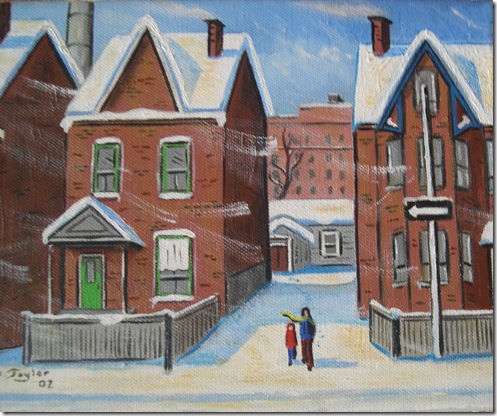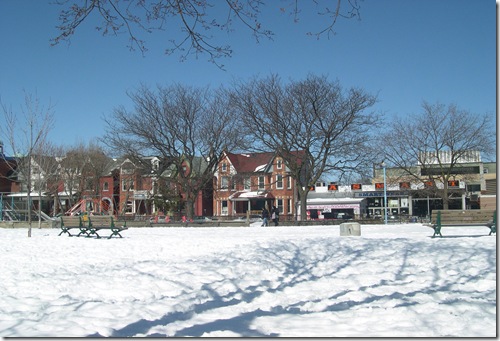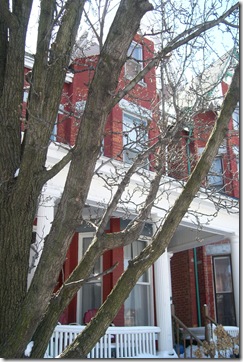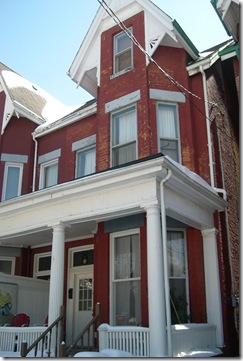Houses on Bellevue Avenue in Kensington Market, the Toronto Western Hospital in the background
acrylic on stretched canvas, 8 ‘ by 10”
Bellevue Square in the heart of the Kensington Market
Victorian houses on Wales Avenue, in the Kensington Market
The early-day history of the Kensington Market
In 1815, George Denison purchased building lot number seventeen from Alexander Grant, and park lot 18 from Major E. B. Littlehayes. These properties were bounded by the modern-day streets of Spadina, Dundas Street West, Lippincott, and Bloor. The modern-day Kensington Market is within these boundaries.
The same year that George Denison acquired the land, he commenced construction of a home on the property, and named it Belle Vue. It was located on the land that today is the site of the Kiever Synagogue, at the northwest corner of Bellevue Square Park. When he built his new home, he was forty-two years of age. He ordered that the land in front of Belle Vue be cleared to create an open square—a promenade in which to stroll. It also created an impressive setting for the home, amid the surrounding forests. Because Denison was a colonel in the militia, the square was used occasionally to drill troops or stage a military parade. The Denison Family eventually donated the square to the city, and today it exists as Bellevue Square Park. It is in the heart of the modern-day Kensington Market and is the scene of many community events.
George Taylor Denison and Esther (nee Lippincott) raised three children in Belle Vue—Richard Lippincott (born 1814), George Taylor II (born 1816), and Robert Brittain (born 1821). The youngest son, Robert, inherited Belle Vue when his father died in 1853. Shortly after he gained title to the property, he hired J. Stoughton Dennis to subdivide the estate into individual lots suitable for erecting homes. This had become necessary as he needed funds to pay the daily living expenses at Belle Vue.
If he were to find purchasers for the building lots, it was essential that they carve streets out of the wilderness to allow public access to the sites. The streets were named after places in England, such as Oxford, Cambridge (now Nassau), and Wales. Other names were derived from the Denison family. In the years ahead, Robert Denison was influential in the life of the city. He served in the militia and fought against the Fenians when they raided Canada in the 1860s. He donated the land and funds to erect the Anglican Church of St. Stephen in the Fields, which remains in existence today at the southeast corner of Bellevue Avenue and College Street. He also served for many years on the City Council, as the alderman for St. Patrick’s Ward.
Robert sold Belle Vue in 1889 and they demolished the home in 1890. When he died in 1900, virtually no land from the original park lot remained in his possession, other than the small piece of property that his home occupied.
The Denison Family’s Legacy in Present-day Toronto
Robert’s older brother, Richard Lippincott Denison, married Susan Hepbourne. Their home, Dover Court, was built in 1839 and named after his mother’s ancestral home in Essex. At that time it was a rural setting amid the forest, surrounded with floral gardens and orchards. Robert’s other brother, George Taylor Denison II, married Mary Anne Dewson, and their home was named Rush Holme, near present-day Dovercourt and College. They raised eight sons and one daughter on the estate.
The names and homes of these members of the Denison family are reflected in the street names of the downtown area of Toronto—Lippincott, Hepbourne, Dewson, Rusholme, and Dovercourt, all of which survive to this day.
The information above is from the book “The Villages Within,” nominated for the Toronto Heritage Awards.



